1
Exploring a New Frontier ..."We made out first contact with the Department of Transport about five years ago (1950), Mr Cruickshank recalls. "It wasn't actually an application. It was more in the nature of a request that we be kept informed of all developments so that we could apply when the time seemed ripe."
Keeping informed on all developments, it turned out, was a sure way of getting caught in the line of fire on a great many conflicts. The amazing growth of the industry was creating problems, circumstances and equipment faster than anyone could digest.
Mr. Cruickshank doesn't regret, delaying his formal application until the industry had more closely approached normalcy although at the same time, he concedes it is unlikely the application could have been readied any earlier.
"By implementing our television operation at this time we are better prepared to offer programming and commercial service with a more full-trained staff than would have been possible even six months ago," says Mr. Cruickshank. " And at a considerable monetary saving to us and our clients." (OST-1, 1955, p. 19)
In 1954, W.T. "Doc" Cruickshank bought Warren House, a TV, stereo and electrical supply store in town "just because he wanted a shop again." (LFP-5, 1970). Just as he entered the radio business through the running of radio shop, he purchased a TV store just before entering into the television business. Doc Cruickshank was 59 years old when he plunged into the fascinating and complex world of television. It was a costly and risky venture in this area described recently (1970) to the CRTC as a "non market." But Doc, his brother John, manager of the radio station, and son, Bud, made it go. (LFP-5, 1970)p.1
1954-55 - The government had set aside channels for every area of the country and Channel 8 had been designated for the Owen Sound area north of Wingham though few thought a television station could survive in such a low population base. But the National Broadcasting Company in the US meanwhile had applied for Channel 8 for a station in Buffalo and by international agreement no two cities within 170 miles of each other could have the same channel. If Buffalo got the station Wingham couldn't have one. (50 years, 1976, p.7-8)
Doc went to Ottawa and presented plans for a small scale television station for a cost of about $125,000 and asked for Channel 8. The commissioners heard him and promised they would hold the channel open for him, but asked him to work out plans for a more powerful station. (50 years, 1976, p.7-8)
On investigation, Doc found out that a suitable station of the kind the commissioners wanted would cost $500,000 and would need $250,000 in revenue annually to meet expenses. The largest single expense was for transmission equipment: $223,000. Again RCA Victor helped out. Then the supplier for the 650 foot transmission tower agreed to take deferred payments on the $100,000 project. (50 years, 1976, p.7-8)
There was still the problem of the building required. The old location downtown was far too small to include a television station. In addition, a higher site was needed for a television station. The Wingham area was getting a new high school at the time and knowing the problem, the town agreed to sell the old high school building to Doc for $1.00. It still required a lot of renovation but at least the station had a home. Normally it takes a year to put a new station on air. The CKNX crew of 65 involved in starting up CKNX television took only three months. The station went on air on November 18, 1955. (50 years, 1976, p.7-8) (VS-1, 1976)
"Mr. Cruickshank feels that the initiation of television completes the working cycle of his life: from silent movie operator, to broadcast sound, and finally the ultimate marriage of the two in the marvel of the electronic age - television." (OST-1, 1955, p. 19)
2
W.T. Cruickshank, K.G. Gilchrist, RCA rep, G.W. Cruickshank, & Scott Reid plan for new TV station1954
920 CKNX, Wingham, Ontario
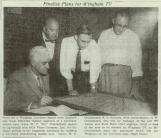 Credits:
Credits:North Huron Museum, Wingham, Ontario
3
Sold for a Dollar ...The town of Wingham sold the original high school building for a dollar. The building had not been harmed by an earlier fire at the quonset huts students were temporarily using while the new high school was being built. Mayor R.E. McKinney presented the deed of the building to W.T. Cruickshank in May of 1955, in the presence of local politicians who had helped Doc secure a television license. (100 Yrs, 110-111) CKNX was the 13th television station to go on air in Canada.
When CKNX received the TV license, the town gave the station the old high school on the corner of John Street East and Carling Terrace for $1. The old high school had been built in 1907 on five vacant lots on the east side of Carling Street (later renamed Carling Terrace), south of John Street. Most of the land of the original high school, including the portion of William Armour's farm to the east of the five lots, remained occupied by the new high school after its opening in 1955. (100 Yrs, 109) The contents of the radio studios and offices were moved there from the Shaw building on Josephine Street in 1955. (MM, 159)
Wingham had a population of 2,802 - when CKNX-TV went on air, it became the smallest town in North America to boast a TV station. (TS-1, 1955)
4
W.T. Cruickshank holding title to the former Wingham Public School, sold to him by the town for $1.1955
920 CKNX, Wingham, Ontario
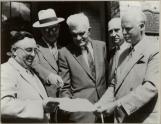 Credits:
Credits:North Huron Museum, Wingham, Ontario
5
CKNX spent $20,000 and put on an addition to house the TV studiospre 1955
old Wingham High School, John Street, Wingham, Ontario
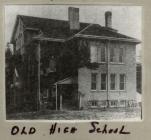 Credits:
Credits:North Huron Museum, Wingham, Ontario
6
TV Station Renovations ...The old Wingham high school was sold for $1, but had $20,000 in renovations done to retrofit it as a television and radio station. A TV studio was added to the front of the building. The Star article notes that "If the station needs another studio, it has only to move 100 yards to the new school which has a 50 feet deep stage and an auditorium capacity of 1,000. 'This wouldn't happen everywhere in Canada,' observed Vin Dittmer. (TS-1, 1955)
For TV, there was only one camera and everything was live. There was 32 hours of broadcasting - news, music shows. Circle 8 Ranch was on Tuesday at 7:30, News from 6-6:30. The first show on TV was Focus - a news program that come on at 6:00 pm. John Strong was the news director and read the news, Bob Carbert dealt with farm issues, Ross Hamilton did the weather - the weather map was an outline of western Ontario painted on glass. Ed Blake did the sports. (I-1, 2006)
CKNX TV equipment
-the studio is 35 x 50 feet
-there is a permanent kitchen set
-2 studio cameras
-they use remote 16 mm sound-on-film
-complete telecine facilities (CKNX-TV-SB, 1958) p.2
7
Old Wingham High School was transformed into the CKNX studios for radio and television in 3 mos.1955
CKNX radio and television studios, John Street, Wingham, Ontario
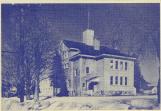 Credits:
Credits:North Huron Museum, Wingham, Ontario
8
Canada's Entry into Television ..."We are very pleased to welcome CKNX-TV, Wingham, as the newest partner in Canada's national television system. It is the thirtieth Canadian television station to go into operation since Canadian TV was launched three short years ago. And it is the thirtieth extension of the national television network which already had made Canadian television available to almost seventy-five per cent of our population. (OST-4, 1955, p. 19)
When Canadians undertook to develop their own television system across a country almost 4,000 miles broad and containing only about fifteen million people, they embarked on what will probably prove to be one of the great projects in Canadian history. And the partnership of public and private enterprise working together with the interest and support of Canadians everywhere, has already achieved some world records for Canada. We have seen, for example the fastest growth in television population coverage anywhere. We have seen the simultaneous construction of eight CBC stations and the addition to the CBC-TV network of twenty-two private stations which act as affiliates as well as providing a vital community service in their own areas. We have developed an extensive service of national programs on television recordings to television stations beyond the reach of the present interconnected microwave system. And from the beginning we have built up two separate program services in two languages simultaneously. The physical development, growing out of a partnership of public and private enterprise has been tremendous. And the medium is still very young in Canada. But with television we have one of the most vivid means ever devised for conveying ideas, impressions and information to people's minds. This means that the real worth of television to Canadians now and in the future lies in the content of its programs, or what it conveys. (OST-4, 1955, p. 19)
The real challenge to Canada in television lies in the production of a substantial amount of Canadian programming by and for Canadians and in linking our country together so that all Canadians have an opportunity to share these programs. In CBC we do not believe that all programs should be Canadian. We have always believed that Canadian want CBC to bring to our service programs from other countries as well. But we do think it essential for the development of Canada as a nation that there be a reasonable amount of program production done by our own people for our own people so that telelvision may become a means of Canadians communicating among themselves. We believe that our television system should be such that it provides possibilities for Canadian writers and performers for a great variety of Canadian people, to use this medium to convey ideas, information and talent. (OST-4, 1955, p. 19)
9
Aerial shot of CKNX radio and television building, pre 19621955-1961
old Wingham High School, John Street, Wingham, Ontario
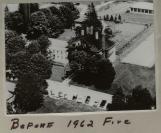 Credits:
Credits:Wingham Library, Wingham, Ontario
10
TV Coverage Area ...CKNX Television coverage included Owen Sound, Arthur, Durham, Harriston, Markdale, Mitchell, Palmerston, Port Elgin, Goderich, Chesley, Meaford, Kincardine, Mount Forest, Seaforth, Thornbury, Southampton, Wiarton, Clinton, Hanover, Listowel, Milverton, Shelburne, Walkerton, Wingham. (this is Channel 8 booklet)
CKNX-TV's signals went out to communities within a 65 mile radius to the north, south and east. It served the eighth largest area of the province's 16 licensed outlets. The transmitting tower is 650 high - 70 feet higher than that of CBLT. (TS-1, 1955)
CKNX-TV will reach 460,756 people and more than 60 per cent of them are rural. It will be available to 23 towns with populations over 1,000 - Owen Sound, Hanover, Goderich, Walkerton, Listowel, Meaford, Shelburne, Wiarton and Kincardine. (TS-1, 1955)
Leading up to the start of CKNX-TV, television sets were selling like hotcakes in Wingham. (TS-1, 1955)
Prior to CKNX-TV going on air, Wingham got only limited television reception from London, Kitchener and none from US stations (TS-1, 1955) At the time (1955) the CBC network was available to only 75 per cent of the Canadian population. There was no CTV network then. Those residents out of transmitter range of London, Kitchener and Toronto have CKNX to thank for having any television service at all for the past 16 years. (LFP-5, 1970) p. 1
In 1958, the population reached by CKNX's broadcasting signal is 190,000. Homes with black and white televisions within that area is 25,000, homes with TVs is 35,000. There are 19,000 urban homes, 35,000 rural homes bringing homes within the area to a total of 54,000. (CKNX-TV-SB, 1958)p.6
In 1958, CKNX-TV is the 16th largest market in Canada out of 32. Below Wingham (190,000) is Regina with 118,000, Sault Ste Marie with 57,900, Peterboro with 163,800, Kingston with 132,000, Sudbury with 98,900 and Sydney with 108,800. (CKNX-TV-SB, 1958)p.7
11
Radius of CKNX's television reception in 19551955
Channel 8, CKNX-TV, Wingham, Ontario
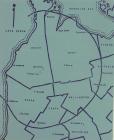 Credits:
Credits:North Huron Museum, Wingham, Ontario
12
Transmitter Facts ...Power - 36,000 watts for picture, 19,000 watts for sound
Tower - 650 ft. above ground, 793 ft above average terrain, 1800 ft above sea level
(this is Channel 8 booklet, c. 1955)
Transmitter site located 4 miles south of Walkerton, 1 mile north of Formosa because land elevation raises transmitter to height of 1800 feet above sea level to enable a strong signal that can reach the city of Owen Sound, which has an elevation of @ 600 feet. (this is Channel 8 … booklet, c. 1955)
All network programs are beamed from Canadian National Telegraph in Kitchener to a 300 ft tower at Moorefield and finally to 150 ft tower outside CKNX television studio. (this is Channel 8 booklet, c. 1955)
Power increased to 180,000 watts for the TV station in 1958. It was approved by the Department of Transportation. (Overlooking Western Ontario, 1958 - printed by Wingham Advance-Times)
1968 - "the radio station multiplied its power from 2500 to 10,000 watts.
The television station switched to colour." (50 years, 1976, p.10) (VS-1, 1976)
On November 21, 1968 CKNX increased power to 10,000 watts night (full-time) from the same site - Highway 43, three and a half miles south of town, Lot 42, Concession 11, Wawanosh Township), using four 227 foot towers. (Barndance brochure)
13
The original TV transmitter was housed at the new site out by Formosa, Ontario.1955
Channel 8, CKNX-TV, Wingham, Ontario
 Credits:
Credits:Wingham Library, Wingham, Ontario
14
Telecine Room ..."one of the most vital departments - it is where slides, films & opaque cards are reproduced. Adjoining the telecine room is the film library where filmed presentations are viewed and edited before being telecast." (this is Channel 8 booklet, c. 1955)
Television Language
-Keg - "baby spotlight
-Pan Head - device which allows TV cameras to "pan" out for a panoramic view
-Barn Door - device like a set of blinders to direct a light's illumination forward
-D.A. - distribution amplifier
-sink jennies - synchronous generators
-stable amps - stabilizing amplifiers
-jeep receivers - TV receiving sets which fed video and audio signals by cable rather than by taking pictures and sound from the air
-video patch panels - used to link feeds and circuits
-aces, deuces, and inkies - spotlights in various sizes (OST-18, 1955, p. 3)